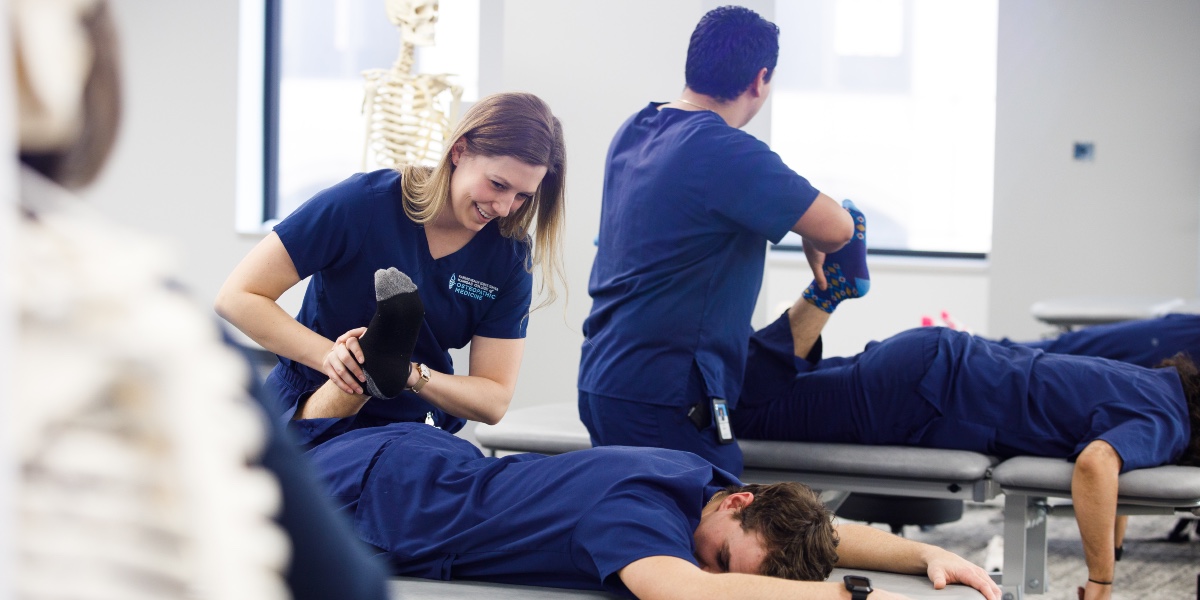What Is Muscle Energy Technique?
Muscle Energy Technique (MET) is a manual therapy in osteopathic medicine developed by Fred Mitchell Sr., DO, in 1948 and is one of the many techniques taught in the osteopathic curriculum at KansasCOM. MET uses the patient’s muscle force in controlled isometric contractions to actively participate in their treatment, guided by a practitioner’s counterforce. This method is rooted in two key physiological processes: autogenic and reciprocal inhibition.
- Autogenic inhibition is activated when a muscle contracts and then relaxes, allowing for a deeper and more effective stretch. This occurs due to the response of Golgi tendon organs, which are sensors within the muscle that regulate tension. When these organs sense too much tension, they signal the muscle to relax.
- Reciprocal inhibition involves contracting one muscle group to relax and lengthen the opposing group. This is beneficial in therapeutic settings to ensure that when one muscle tightens, its opposite muscle can effectively relax, promoting balance and proper motion.
MET is particularly distinct for how it engages directly with what are known as “restrictive barriers.” These barriers are natural limits within the body that restrict the range of motion. Engaging them directly allows practitioners to address and manipulate the body’s response to stretch and tension. This direct engagement is crucial for correcting misalignments and enhancing mobility.
By teaching students how to apply MET, KansasCOM ensures they grasp both the theory and practical application of these techniques, preparing them for successful careers in osteopathic medicine.
How Does Muscle Energy Technique Work?
Muscle Energy Technique (MET) is about understanding the physiological interactions within the body and applying these principles in clinical practice. At KansasCOM, we ensure our students understand the theory and practical applications of MET used by osteopathic physicians (DOs). Here’s an overview of the key muscle structures involved and how DOs use MET to treat patients:
- Golgi tendon organs are receptors within the muscle that sense tension and help regulate muscle force. With MET, DOs use this response to manage and reduce excessive muscle contraction. When a muscle contracts too strongly, Golgi tendon organs signal the nervous system to inhibit this contraction, activating the opposing (antagonist) muscle group. DOs use this mechanism to control muscle tension and prevent injury during treatment.
- Muscle spindles are receptors located throughout a muscle and detect changes in muscle length. They are essential for coordinating movements and maintaining muscle tone. During MET, when a DO instructs a patient to stretch or contract a muscle, muscle spindles help regulate the contraction and ensure the opposing muscles relax appropriately. This supports the body’s natural balance and alignment.
Applying Muscle Energy Technique in Clinical Settings
- Post-isometric relaxation is a technique DOs commonly use to address hypertonic (overly tense) muscles. A DO guides the patient to gently contract a tense muscle against a controlled resistance offered by the physician. After the contraction, the muscle is in a state more conducive to relaxation. The DO then leads the muscle into a further stretch, capitalizing on the reduced tension to improve the range of motion.
- With reciprocal inhibition, a DO uses the natural response of muscle spindles to facilitate the stretching and relaxation of muscles. When the patient contracts a muscle group, the opposing muscle group automatically relaxes, which a DO uses to ease the treatment of affected areas, enhancing flexibility and mobility.
These techniques allow DOs to effectively manage and treat musculoskeletal conditions, from simple muscle tightness to more complex alignment issues. KansasCOM prepares students to apply these techniques effectively through detailed, hands-on approaches, ensuring they are well-equipped to provide integrative, patient-centered care.
What Are the Benefits and Applications of Muscle Energy Technique?
Osteopathic muscle energy techniques can provide nonpharmacological relief for conditions like back pain, tension headaches, sports injuries, and chronic pain. A systematic review of studies confirmed that MET effectively reduces pain intensity, improves lumbar spine range of motion, and diminishes functional disability in patients with chronic low back pain.
MET helps restore normal function in muscles and joints by reducing muscle tension and enhancing range of motion. Athletes often use it to prevent injuries and maintain mobility, while osteopathic practitioners apply it to alleviate discomfort caused by musculoskeletal disorders. MET is ideal for those seeking noninvasive treatment options, those with limited range of motion, and anyone needing relief from musculoskeletal discomfort without medication.
KansasCOM’s Commitment to Osteopathic Excellence
KansasCOM is rooted in the traditions of osteopathic medicine, emphasizing an integrative approach to patient care and the body’s intrinsic ability to heal and regulate itself. Muscle Energy Technique (MET) embodies this philosophy by using the body’s mechanisms to encourage self-healing and self-regulation. MET reflects the osteopathic commitment to understanding the interrelationships of the body’s structures and functions.
By incorporating MET into our curriculum, KansasCOM ensures students learn a highly effective manual therapy technique and understand how it exemplifies larger osteopathic principles. This approach prepares our graduates to apply a patient-centered approach to health care, making them well-equipped for successful careers in osteopathic medicine.
Join the KansasCOM Community
Interested in pursuing a career in osteopathic medicine? KansasCOM offers a rigorous education that prepares students to excel in the field. Learn more about KansasCOM’s Doctor of Osteopathic Medicine program and how we can help you achieve your professional goals.

